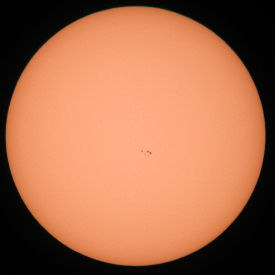<<PREVIOUS -
HOME -
CONTENTS -
NEXT>> -
![]()
<<PREVIOUS -
HOME -
CONTENTS -
NEXT>> -
![]()

David Haworth presented the Sunriver Observatory Astrophotography Workshop from 1:00 pm Friday through Sunday 5:30 pm. Each attendee learned how to image the Sun and deep sky objects. The attendees received a CD with over 1,800 PDF pages of presentations and several images to image process. Also, two DVDs with internet software and star catalogs were given out free.

Friday
David Haworth started the workshop with hands-on solar imaging with the Nikon Coolpix 990 camera with the Orion 80mmED telescope. Each attendee learned tips on finding the Sun, focusing the camera and using a remote cable to take several solar images. Paul Poncy’s Coolpix 995 camera was used when he took his images. After solar imaging David Haworth presented an Introduction to Astrophotography until dinner time.
At 7:00 pm the attendees installed InfanView software and selected the best solar image taken that afternoon by all the attendees. Using the best solar image the attendees installed GIMP software, resized the image, sharpened the image and saved the image as a JPG for web viewing.
Around 9:00 pm the attendees went outside and David Haworth helped Paul Poncy with his Coolpix 995 camera to take images of the Moon and Venus.
After the Moon went down David Haworth set up the Orion StarShoot camera with the Orion 80mmED for deep sky imaging, David Haworth showed the attendees how to align the optics with the mount’s mechanical RA axis and to implement a simple polar alignment using the finder scope. With this setup David Haworth imaged M51 until clouds closed out the sky.
Meanwhile two other StarShoots were being used in the Sunriver Observatory for imaging. Debbie Deutschman imaged M57 with the Meade telescope and Bob Grossfeld, Larry Cerullo and Bill Arthur imaged M51 using the Celestron refractor. The group stopped just before 2:00 am because of clouds.
Saturday
Saturday afternoon the attendees worked on the Sunriver Observatory solar telescopes. Paul Poncy’s Coolpix 995 camera with David Haworth’s Tele Vue eyepiece adapters were used to afocal image through the eyepiece on the Coronado Calcium K solar telescope. Coolpix 995 camera video output was used to show the live image on the television in the observatory. Bill Arthur tried using the Orion StarShoot camera on the Celestron refractor but had problems with finding and focusing on the white light Sun. Next time it would help if the Orion StarShoot camera was used with a flip mirror. Larry Cerullo used his Nikon D40 on the Celestron refractor with a white light solar filter
After Saturday dinner the attendees installed DeepSkyStacker and PixInsight software in preparation to process deep sky images on Sunday. David Haworth presented the first half of Introduction to Image Processing. Later in the evening the Moon and Venus were within one degree of each other and the attendees all went out to view the Moon and Venus. David Haworth worked with Paul Poncy on taking images of the Moon and Venus with the Sunriver Observatory in the bottom of the image. From 9:00 pm to 11:00 pm the attendees helped at the Sunriver Observatory public viewing session. David Haworth setup the Nikon Coolpix 990 on the Tele Vue refractor showing the Moon on the television. Debbie Deutschman imaged Venus and Moon with the StarShoot camera and Meade telescope.
Sunday
Sunday afternoon David Haworth presented the last part of the Introduction to Image Processing. The attendees processed M12 as an example with DeepSkyStacker and PixInsight software. Next, M51 which was taken Friday night was image processed. Last, Debbie Deutschman processed M57 with good results. M51 images taken with the Celestron refractor could not be stacked because of the lack of focused stars.
Workshop Deep Sky Imaging Notes
Workshop Afocal Imaging Notes
Workshop DSLR Imaging Notes